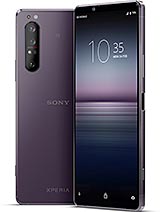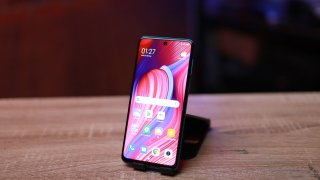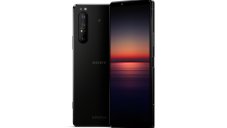Sony Xperia 1 II

- 6.5" 1644x3840 pixels
- 12MP 2160p
- 8GB RAM Snapdragon 865
- 4000mAh Li-Po
Phone Finder
- Acer alcatel Allview Amazon Amoi Apple Archos Asus AT&T Benefon BenQ BenQ-Siemens Bird BlackBerry Blackview BLU Bosch BQ Casio Cat Celkon Chea Coolpad Cubot Dell Doogee Emporia Energizer Ericsson Eten Fairphone Fujitsu Siemens Garmin-Asus Gigabyte Gionee Google Haier HMD Honor HP HTC Huawei i-mate i-mobile Icemobile Infinix Innostream iNQ Intex itel Jolla Karbonn Kyocera Lava LeEco Lenovo LG Maxon Maxwest Meizu Micromax Microsoft Mitac Mitsubishi Modu Motorola MWg NEC Neonode NIU Nokia Nothing Nvidia O2 OnePlus Oppo Orange Oscal Oukitel Palm Panasonic Pantech Parla Philips Plum Posh Prestigio QMobile Qtek Razer Realme Sagem Samsung Sendo Sewon Sharp Siemens Sonim Sony Sony Ericsson Spice T-Mobile TCL Tecno Tel.Me. Telit Thuraya Toshiba Ulefone Umidigi Unnecto Vertu verykool vivo VK Mobile Vodafone Wiko WND XCute Xiaomi XOLO Yezz Yota YU ZTE
Sony Xperia 1 II Summary
1. Name
Sony Xperia 1 II was introduced in February 2020. The phone is said to be launched in India on June 29.
Xperia 1 II is basically built on its predecessor, the Xperia 1, but with more storage and RAM, a large battery, and a higher-end processor. Apart from that, the cameras have also been enhanced, and a 3.5mm headphone jack has been added.
2. Screen
Sony is the only OEM on the market that manufactures a 4K display. The main reason here is other manufacturers do not think anything higher than QHD is necessary.
The screen is on the larger end, standing at 6.5 inches and has a one-of-a-kind aspect ratio of 21:9, which also makes Sony the first to take advantage of this format.
There is no notch on this device like many other smartphones releasing in the last few years. Instead, Sony opted for a small bezel around the bottom and top of the phone to house the selfie camera and the front-facing speakers.
The logic for this decision is if it has gone all the way to make a phone with this aspect ratio, why taking a chunk out of the perfect square screen?
The 4K resolution is Sony’s exclusive offer and that pairing with the OLED screen makes for an unrivalled experience.
The OLED technology helps increasing the brightness all while saving power for the device.
The highlight of this screen is that it does not need to be back lit as its organic diode can generate light on its own, thus saving lots of power.
The 21:9 aspect ratio makes gaming on this phone enjoyable. Even with the most demanding titles, Sony Xperia 1 II can still retain smooth frame rates. The unique aspect ratio also give you an advantage over rivals using the 16:9 smartphones, like you can see an enemy sooner, for example.
The 21:9 screen is designed for content consuming need of the majority of users, who spend hours of their free time streaming movies and games. The idea here is to offer users an immersive cinematic experience without the annoying black bars on the top and bottom of the screen, or at the sides.
One of the most serious downside of the screen is that the content you stream need to fit into the 21:9 aspect ratio. Users will have a hard time finding content in that format, Most YouTube videos automatically scale to 16:9 ratio to fit most current phone screens, but there are some available for you.
Another disadvantage is for content that is non-cinematic, that long screen does not make much of a noticeable different.
3. Chipset
Under the hood, Sony Xperia 1 II runs on the high-end Qualcomm Snapdragon 865 processor. The same chipset inside many top-end phones released in 2020, including the Galaxy S20 lineup in some parts of the world.
In short, Qualcomm Snapdragon 865 is quite a leap compared to the Snapdragon 855 introduced in 2019. With AI and 5G support, Qualcomm has managed to bridge the gaps with Apple in this respect.
One of the most noticeable improvements of Snapdragon 865 is the better memory latency, which promises shorter loading time and smoother overall performance.
With this chipset, Qualcomm has realized its ambition of stepping into the gaming industry. Its Adreno 650’s rendering speed is 25% faster but its power consumption is 35% less.
With enhanced thermal efficiency, you can expect the Adreno 650 to remain as its peak performance longer.
4. RAM
The Qualcomm Snapdragon 865 comes with RAM of 8GB (this is the only choice you have), which should ensure that the Sony Xperia 1 II is as responsive as you need it to be.
Overall, that much RAM means the phone can run games very well with relatively short loading time and no stutters.
Along with that, you have inbuilt storage of 256GB, enough space for your media and apps. If you feel needed, there is a microSD card slot to extend the storage even further.
5. Battery
Sony Xperia 1 II is powered by a 4,000mAh battery with support for Qi Wireless charging and USB PD fast-charging, sound quite big but given that it has to provide power for a 4K display measuring, the phone can last for only one day under intensive use. But that is long enough for most of us.
The phone has a special feature just for gaming called H.S Power Control, H.S stands for Heat Suppression. What it does is to switch the phone to draw power directly from the charger instead of battery. This also minimize the heat the phone generates after long hours of gaming.
Even if users do not use the HS feature, Sony Xperia 1 II’s passive cooling ability is obviously better than that of its predecessor.
6. Camera
Sony Xperia 1 II sports a quad-camera setup, consisting of a 12MP f/2.4 telephoto lens, a 12MP f/2.2 ultrawide camera, 12MP f/1.7 wide snapper, and a 0.3MP time of flight sensor, housed by a camera bump on the back.
In tests, the phone’s autofocus is fast and it can take extremely sharp photos. The colors are accurate so what you have is a true portrait of the subject, not something too radiant or punchy-looking like what you have with iPhones and Samsung phones.
Xperia 1 II offers a wide range of frame rates and resolutions when it comes to shooting videos. It can give you up to 4K, 60 FPS or Full HD, 120 FPS.
Sony has done a good job giving users an impressive stabilization technology, which allows for hand-held shooting without the results looking shaky.
As a phone for content creator, Sony Xperia 1 II has a wide range of professional apps for both photos and videos. They let users tweak quite a lot of settings. If you are a passionate photographer, this phone will allow for some awesome-looking results.
Compared to its predecessor, the Xperia 1, Xperia 1 II has the extra Time of Flight sensor. Both of them have an 8 MP selfie camera.
Sony Xperia 1 II Full Specifications
- Technology GSM / HSPA / LTE / 5G
- 2G bands GSM 850 / 900 / 1800 / 1900 - SIM 1 & SIM 2
- 3G bands HSDPA 800 / 850 / 900 / 1700(AWS) / 1900 / 2100
- 4G bands 1, 2, 3, 4, 5, 7, 8, 12, 13, 17, 19, 20, 25, 26, 28, 29, 32, 34, 38, 39, 40, 41, 46, 66
- 5G bands 1, 3, 28, 77, 78 NSA/Sub6
- Speed HSPA 42.2/5.76 Mbps, LTE-A (6CA) Cat19 1600/150 Mbps, 5G (2+ Gbps DL)
- Announced 2020, February 24
- Status Available. Released 2020, May 22
- Dimensions 165.1 x 71.1 x 7.6 mm (6.5 x 2.80 x 0.30 in)
- Weight 181.4 g (6.38 oz)
- Build Glass front (Gorilla Glass 6), glass back (Gorilla Glass 6), aluminum frame
- SIM Hybrid Dual SIM (Nano-SIM, dual stand-by)
- IP65/IP68 dust/water resistant (up to 1.5m for 30 mins)
- Type OLED capacitive touchscreen, 1B colors
- Size 6.5 inches, 98.6 cm2 (~84.0% screen-to-body ratio)
- Resolution 1644 x 3840 pixels, 21:9 ratio (~643 ppi density)
- Protection Corning Gorilla Glass 6
- HDR BT.2020
- OS Android 10
- Chipset Qualcomm SM8250 Snapdragon 865 (7 nm+)
- CPU Octa-core (1x2.84 GHz Kryo 585 & 3x2.42 GHz Kryo 585 & 4x1.8 GHz Kryo 585)
- GPU Adreno 650
- Card slot microSDXC (uses shared SIM slot)
- Internal 256GB 8GB RAM
- UFS
- Modules 12 MP, f/1.7, 24mm (wide), 1/1.7", Dual Pixel PDAF, OIS 12 MP, f/2.4, 70mm (telephoto), 1/3.4", 1.0µm, PDAF, 3x optical zoom, OIS 12 MP, f/2.2, 16mm (ultrawide), 1/2.55", Dual Pixel PDAF 0.3 MP, TOF 3D, (depth)
- Features Zeiss optics, LED flash, panorama, HDR, eye tracking
- Video 2160p@24/25/30/60fps HDR, 1080p@30/60/120fps; 5-axis gyro-EIS, OIS
- Modules 8 MP, f/2.0, 24mm (wide), 1/4", 1.12µm
- Features HDR
- Video 1080p@30fps (5-axis gyro-EIS)
- Loudspeaker Yes, with stereo speakers
- 3.5mm jack Yes
- 24-bit/192kHz audio Dynamic vibration system
- WLAN Wi-Fi 802.11 a/b/g/n/ac/ax, dual-band, Wi-Fi Direct, DLNA, hotspot
- Bluetooth 5.1, A2DP, aptX HD, LE
- GPS Yes, with A-GPS, GLONASS, BDS, GALILEO
- NFC Yes
- Radio No
- USB 3.1, Type-C 1.0 reversible connector; USB On-The-Go
- Sensors Fingerprint (side-mounted), accelerometer, gyro, proximity, barometer, compass, color spectrum
- Non-removable Li-Po 4000 mAh battery
- Charging Fast charging 21W Wireless charging USB Power Delivery
- Colors Black, Purple
Sony Xperia 1 II News

Mobile - Apr 11, 2020
15 Most Exciting Smartphones In The First Half Of 2020 That're Worth The Wait

Review - Feb 27, 2020
Sony Xperia 1 II Hands-On: Similar Design; Better Cameras; Headphone Jack

Mobile - Feb 24, 2020





